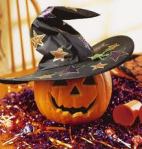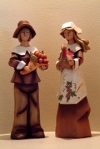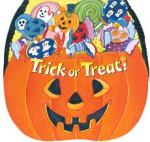 America’s favorite holiday is right around the corner and Do-it-yourselfers are dusting off their sewing machines and power tools in order to make their own costumes and decorate their homes. They’re also getting out their cookbooks and consulting online cooking sites to make homemade Halloween treats to please young and old alike. A lot of my students don’t really understand the significance of Halloween in American culture as it’s seen as a rather pagan and silly tradition and wonder what all the ruckus is about. So…what IS all the hype about?
America’s favorite holiday is right around the corner and Do-it-yourselfers are dusting off their sewing machines and power tools in order to make their own costumes and decorate their homes. They’re also getting out their cookbooks and consulting online cooking sites to make homemade Halloween treats to please young and old alike. A lot of my students don’t really understand the significance of Halloween in American culture as it’s seen as a rather pagan and silly tradition and wonder what all the ruckus is about. So…what IS all the hype about?
As most people know, Americans love to have fun and they also like to commercialize any event or holiday where people can kick off their shoes and celebrate (any excuse for a party…!). This commercialization of Halloween also adds to the enjoyment and festive atmosphere of October 31. It’s the first big holiday of the school year, the true end of the summer season as the fall vegetables turn up on the produce stands (pumpkins, apples, turnips, corn and beets to name only a few) and the kickoff of the holiday season which culminates in the ushering in of the New Year on Times Square in New York City.
The origins of Halloween date back to a Druidic fire festival known as Samhain (summer’s end) from the Old Irish samain.  This festival was a celebration of the end of the harvest season for the Irish, Scottish and Welsh Celts. As it was a time when leaves started to wither and annual plants died as the coolness set in, the Gauls saw fit to commemorate the dead and departed and soon the divisions between the living and the dead blurred. Little by little this day became associated with celebrating the recently departed until by the 19th century November 1 was set aside to pay respect to all Saints in heaven. Thus came the names All Saints Day, then Souls Day, then Hallowed Day (sanctify those departed day) from the Scottish Hallowe-en.
This festival was a celebration of the end of the harvest season for the Irish, Scottish and Welsh Celts. As it was a time when leaves started to wither and annual plants died as the coolness set in, the Gauls saw fit to commemorate the dead and departed and soon the divisions between the living and the dead blurred. Little by little this day became associated with celebrating the recently departed until by the 19th century November 1 was set aside to pay respect to all Saints in heaven. Thus came the names All Saints Day, then Souls Day, then Hallowed Day (sanctify those departed day) from the Scottish Hallowe-en.  Because the celebration was the night before it, wasn’t long before Hallowed eve became Halloween and thus began a tradition of respecting ancient beliefs and rituals which were adopted by the Roman Christians who had earlier conquered the ancient Celts.
Because the celebration was the night before it, wasn’t long before Hallowed eve became Halloween and thus began a tradition of respecting ancient beliefs and rituals which were adopted by the Roman Christians who had earlier conquered the ancient Celts.
So this day became special for the Celts as a way of helping the spirits pass on to the other world. Some spirits though are not so benevolent or need a little special care in passing judgment day or purgatory, so the ancient Celts began the custom of carving turnips and beets and lighting the inside with candles as a way of remembering these lost souls. Americans started using pumpkins in the 19th century to mark the end of harvest time and in the mid 19th century pumpkins became the symbol of Halloween in North America.
This symbol of Halloween is also called a “Jack-o-lantern”.  This term stems from an old Irish folktale about a man called “Stingy Jack” who one day invited the Devil to have a drink with him. Living up to his reputation, Stingy Jack refused to pay for the drinks and through his cunning convinced the Devil to turn himself into a coin so that Jack could pay his bill.
This term stems from an old Irish folktale about a man called “Stingy Jack” who one day invited the Devil to have a drink with him. Living up to his reputation, Stingy Jack refused to pay for the drinks and through his cunning convinced the Devil to turn himself into a coin so that Jack could pay his bill. 
 The Devil accepted and turned himself into a coin. But Jack changed his mind and decided to keep the coin. He put it in his pocket next to a silver cross which prevented the Devil from changing back. But the Devil begged Jack to set him free and Jack did so on the condition that the Devil would not bother him for one year and that if Jack died the Devil had to promise not to claim his soul. Jack continued making deals with the Devil until he eventually died. Because of his bad deeds, as the legend goes, God would not allow such a horrible human being into heaven. The Devil though would not allow Jack into hell because of the promise that he had made to not claim Jack’s soul.
The Devil accepted and turned himself into a coin. But Jack changed his mind and decided to keep the coin. He put it in his pocket next to a silver cross which prevented the Devil from changing back. But the Devil begged Jack to set him free and Jack did so on the condition that the Devil would not bother him for one year and that if Jack died the Devil had to promise not to claim his soul. Jack continued making deals with the Devil until he eventually died. Because of his bad deeds, as the legend goes, God would not allow such a horrible human being into heaven. The Devil though would not allow Jack into hell because of the promise that he had made to not claim Jack’s soul.  So Jack, now homeless, was condemned to roam the earth with only a burning coal that the Devil allowed him to have. Jack put this burning coal into a turnip and has been wandering around the earth ever since. The Irish began to refer to this ghostly figure as “Jack of the Lantern” and then it was shortened to “Jack o’ Lantern”. The Irish American immigrants brought these traditions to America and soon discovered that pumpkins made the ideal “lantern” for Halloween as they were much bigger than turnips and could be carved out more easily. These lanterns were traditionally put on window sills or doorsteps to ward off or frighten away evil spirits such as “Stingy Jack”.
So Jack, now homeless, was condemned to roam the earth with only a burning coal that the Devil allowed him to have. Jack put this burning coal into a turnip and has been wandering around the earth ever since. The Irish began to refer to this ghostly figure as “Jack of the Lantern” and then it was shortened to “Jack o’ Lantern”. The Irish American immigrants brought these traditions to America and soon discovered that pumpkins made the ideal “lantern” for Halloween as they were much bigger than turnips and could be carved out more easily. These lanterns were traditionally put on window sills or doorsteps to ward off or frighten away evil spirits such as “Stingy Jack”. 
The legend of Stingy Jack gave way to other stories of ghoulish beings who played tricks on humans during this nightly celebration (see 18th century Scottish Glasgow poet John Mayne’s poems relating to pranks at Halloween “What fearfu’ pranks ensue!”, Scottish poet Robert Burns’ poem “Halloween” written in 1785 and  19th century American poet Edgar Allan Poe’s poems “The Raven“, “Ligeia” and “Ulalume” to name just a few) and before you knew it Americans picked up these legends and the holiday took on themes of death, evil, the occult or mythical monsters. Black (for death) and orange (for harvest time) became the theme colors. Peasants in early 15th England and Ireland took advantage of these fears that people had of evil spirits, and went from door to door begging for treats (cake, fruit or coins) in exchange for the promise to pray for the souls of the dead and to keep the spirits from playing tricks on the occupants of the house.
19th century American poet Edgar Allan Poe’s poems “The Raven“, “Ligeia” and “Ulalume” to name just a few) and before you knew it Americans picked up these legends and the holiday took on themes of death, evil, the occult or mythical monsters. Black (for death) and orange (for harvest time) became the theme colors. Peasants in early 15th England and Ireland took advantage of these fears that people had of evil spirits, and went from door to door begging for treats (cake, fruit or coins) in exchange for the promise to pray for the souls of the dead and to keep the spirits from playing tricks on the occupants of the house.  The custom was called “souling” and was a common practice at holiday time for beggars.
The custom was called “souling” and was a common practice at holiday time for beggars.
Here’s a reading of the
“Souling” was transformed into “trick or treating” as a reminder of what the beggars said when the homeowners opened their doors. 
 Children soon picked up this custom of going from door to door for food or coins and started the custom of “guising” or disguising themselves in elaborate costumes. They are usually modeled after supernatural figures such as monsters, ghosts, skeletons, witches, and devils. Over time, people started disguising themselves as popular characters from fiction, celebrities with sophisticated rubber masks, and generic images from legends. Of course commercialism had its hand in these traditions also and the first mass-produced Halloween costumes appeared in stores in the 1930s when the custom of trick-or-treating was becoming popular in the United States. Halloween spending is more “treat” than “trick” as people spent more than $6 Billion in costumes and candy in 2010. Wow!
Children soon picked up this custom of going from door to door for food or coins and started the custom of “guising” or disguising themselves in elaborate costumes. They are usually modeled after supernatural figures such as monsters, ghosts, skeletons, witches, and devils. Over time, people started disguising themselves as popular characters from fiction, celebrities with sophisticated rubber masks, and generic images from legends. Of course commercialism had its hand in these traditions also and the first mass-produced Halloween costumes appeared in stores in the 1930s when the custom of trick-or-treating was becoming popular in the United States. Halloween spending is more “treat” than “trick” as people spent more than $6 Billion in costumes and candy in 2010. Wow!
Tim Burton, an American film director and producer famous for dark, strange movies such as Beetlejuice, Edward Scissorhands, Planet of the Apes, and Charlie and the Chocolate Factory to name a few. His latest film, Alice in Wonderland, was the 2nd highest grossing film of 2010. “This Is Halloween” is a song by composer Danny Elfman which Burton included in his film The Nightmare Before Chritmas (play on words of the Christmas poem “Twas Night Before Christmas” by Clement Clark Moore) Sing along with Jack Skellington to practice your stress (a Disney re-cut):
[By the way…for all of my observant students…there were a few mistakes in the subtitles…did you find them? . Here they are: Everybody screm (sp)= everybody scream; Yours stairs = your stairs (possessive pronouns are always invariable); Something’s waiting no (sp) to pounce = now to pounce; Everyone screm (sp) = everybody scream…!]
 In Los Angeles, California, folks from every walk of life flock to “Mr. Bone’s Pumpkin Patch” amusement park to spend a day with the family in a farm like setting and to leave with a perfectly shaped pumpkin to decorate their house.Here’s Paris Hilton leaving with her pumpkin:
In Los Angeles, California, folks from every walk of life flock to “Mr. Bone’s Pumpkin Patch” amusement park to spend a day with the family in a farm like setting and to leave with a perfectly shaped pumpkin to decorate their house.Here’s Paris Hilton leaving with her pumpkin: 
 If Halloween falls on the weekend, people celebrate traditional games such as apple bobbing (with your hands tied behind your back you must “catch” an apple with your teeth in a pail of water) or playing fortune teller with Ouija Boards. It’s also an occasion to sit by the fireplace and tell Gothic ghost stories (Frankenstein and Dracula among others) or view horror films.
If Halloween falls on the weekend, people celebrate traditional games such as apple bobbing (with your hands tied behind your back you must “catch” an apple with your teeth in a pail of water) or playing fortune teller with Ouija Boards. It’s also an occasion to sit by the fireplace and tell Gothic ghost stories (Frankenstein and Dracula among others) or view horror films.  Episodes of television series and Halloween-themed specials are usually shown before Halloween to get people in the holiday spirit. To get in the holiday mood yourself, watch the following Good Morning America special on the traditions of Halloween. But first click on Deb’s Notes on GMA Halloween Special to make sure you understand the words and expressions used in the video.
Episodes of television series and Halloween-themed specials are usually shown before Halloween to get people in the holiday spirit. To get in the holiday mood yourself, watch the following Good Morning America special on the traditions of Halloween. But first click on Deb’s Notes on GMA Halloween Special to make sure you understand the words and expressions used in the video.

It is little doubt that this is the best singer in the world! What makes a singer isn’t their personality, it’s their voice! I don’t like when people judge singers on things that just aren’t that vital. Remember, they are entertainers, not congressmen! Let them do their stuff and enjoy the music!
I love your blog, you should add an RSS feed feature so I can get automatic notifications of new blogs. If you set one up please email me! i will bookmark you for now. Again Excellent Blog!
hey I was quite impressed with the setup you used with this weblog. I use blogs my self so great job. definatly adding to bookmarks.
Major thanks for the article post.Really looking forward to read more.
How we tret our veterans is aweful. They gave their freedom for our country and deserve to be treated like royalty. Thank you!